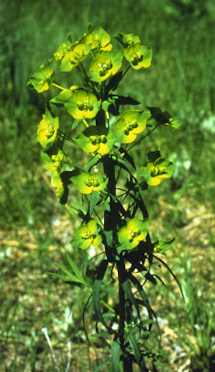leafy spurge (Euphorbia esula) Chemical Control

Description of Plant:
Leafy spurge varies from 1-3 feet in height and grows in patches. Plants reproduce by seeds and vigorous rhizomes. Leafy spurge contains a milky juice or latex. When the plant is injured, the milky latex flows from the injury. Plants have a distinctive green color to them. The yellowish-green bracts which form in early Summer are often mistaken for petals. Its roots can grow as deep as 26 feet and can survive for years underground before sending up new shoots. Leafy spurge is found in much of temperate North America. The biggest leafy spurge patches are found in Montana, North Dakota, and Canada. It grows on road sides, waste areas, cultivated fields, pastures, range land, parks, river banks and ditches. Leafy spurge is one of the hardest noxious weeds to control. The hardest place to control leafy spurge is by rivers and streams because control options are limited. Leafy spurge is not readily grazed by cattle or horses. Sheep and goats utilize the plant and do well on it and they can be an effective method of cultural control. Deer and antelope reportedly graze it, somewhat. Just to say that leafy spurge is a noxious weed is an under statement! It has taken over about 550,000 acres in Montana and is a serious threat to many more acres. In 1992 there was an estimated 30.7 million acres of wild land and an estimated 134,000 acres of it was covered in leafy spurge in Montana. In as early as 1933 leafy spurge was reported to be a serious threat to grazing land.
Useful Herbicides:
2, 4-D (Amine, LV esters), Tordon 22K/Tordon 101, Roundup or similar formulations, Plateau (Imazapic), Banvel (Dicamba)
Herbicide Brand How to Apply When to Apply Roundup or similar formulations Broadcast Apply after July 1 to actively growing plants. Plateau (Imazapic) Broadcast Apply in early to mid-September Banvel (Dicamba) Broadcast During the true flowering growth stage or fall regrowth. 2, 4-D (Amine, LV esters) Broadcast Before Seed Sets or Fall Regrowth Tordon 22K/Tordon 101 Broadcast Before Seed Sets or Fall Regrowth
Further Information About These Herbicides
Herbicide Brand Active Ingredient Mode of Action Roundup or similar formulations Roundup Growth Regulator Herbicide Plateau (Imazapic) Plateau Growth Regulator Herbicide Banvel (Dicamba) Banvel Growth Regulator Herbicide 2, 4-D (Amine, LV esters) 2, 4-D (Amine, LV esters) Growth Regulator Herbicide Tordon 22K/Tordon 101 Tordon 101 plus Sodium TCA, Tordon 101 plus Sylgard. Growth Regulator Herbicide
Other Information
When you find a small patch of leafy spurge then you should spray it and don't just spray the plants but also spray about 10 to 15 feet around each patch to control spreading roots and seedlings. Don't use just grazing to control small patches. The most important thing to remember is to do everything possible to stop the small patch from getting any bigger and to completely eradicate it, because this is the most valuable time to completely prevent them from getting any bigger.
The best way to stop leafy spurge when it is by water because you can't yours herbicides, is to graze it with animals that will eat it such as sheep and goats. Some other good methods you can try to control leafy spurge are by multi-species grazing, burning, or reseeding.
Links
(www.aphis.usda.gov/ppq/weeds/facts.html)Go here for good information about noxious weeds and APHIS management programs.
(http://agecon.lib.umn.edu/index.html)Go here for good information on the economic impacts of leafy spurge and various management tools.
(www.cwma.org) Go here for good information on weed control techniques and weed management programs.
Back to Recommendations By Weed mtwow.org Home
What's worse than a nuclear boom? Weeds are!
By: Ryan Hunt 1/23/03